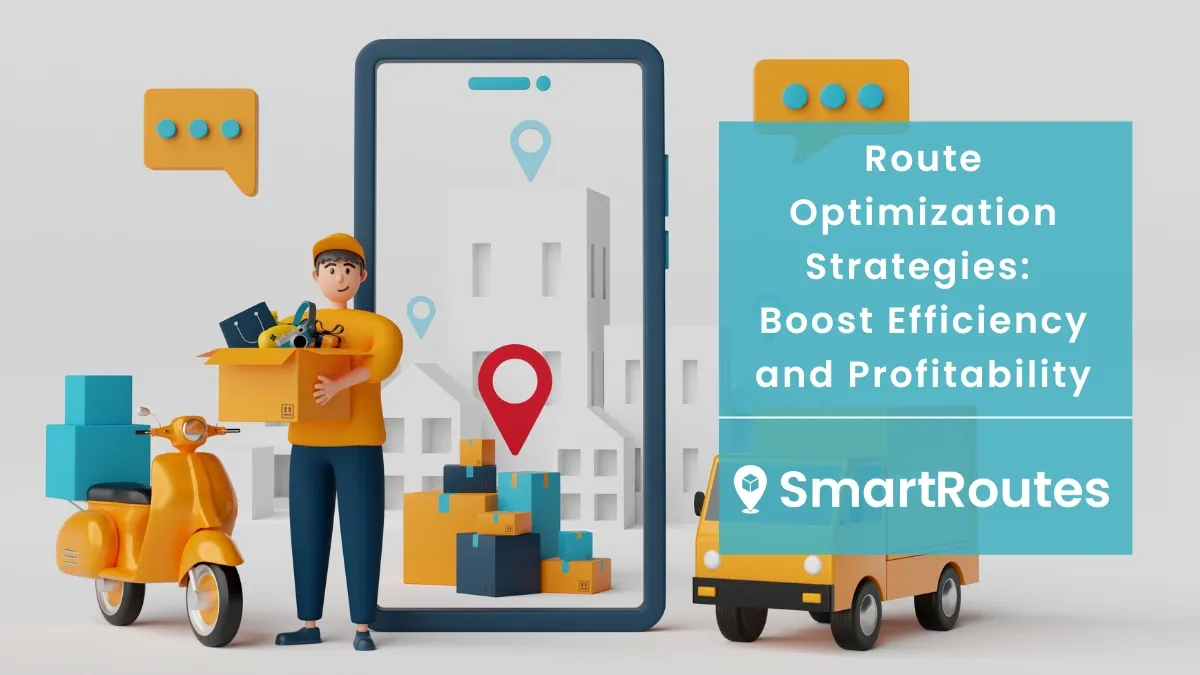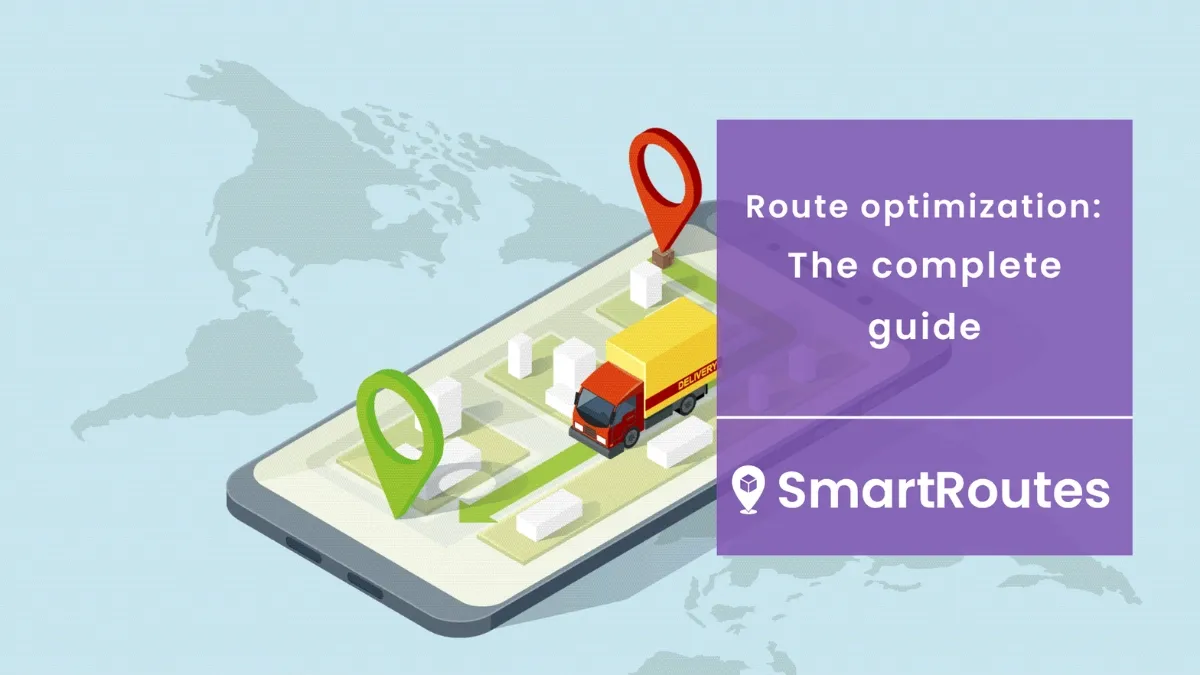Route Optimization Strategies: Boost Efficiency and Profitability
Optimize your delivery routes with strategies that enhance efficiency, reduce costs, and boost customer satisfaction. Discover the best methods for streamlining your logistics operations.

In today's fast-paced business world, catering to the ever-evolving demands of customers is a top priority. If you're a business owner or part of a team responsible for ensuring home deliveries, you know that it's not just about getting products from point A to point B; it's about doing so efficiently, cost-effectively, and to the delight of your customers. This is where route optimization comes to the rescue.
Streamlining your home delivery operations can be a game-changer. Whether you run a local business or manage a nationwide fleet of delivery vehicles, route optimization is a secret weapon you can't afford to overlook. It's all about delivering more with less, and in an era where customer expectations are higher than ever, this can make or break your business.
In this blog, we aim to give you a better understanding of route optimization and how it can be used to boost your delivery efficiency and overall profitability.
- Static Route Optimization
- Dynamic Route Optimization
- Route Optimization Strategies
- How Route Optimization Can Boost Efficiency and Profitability
Static Route Optimization
Static routes are routes that remain consistent and do not change significantly over time. For instance, you might have a predefined route that stays the same every Monday, Tuesday, and so on. While these routes don't undergo frequent alterations, it's essential to optimize them, as even seemingly unchanging routes can benefit from increased efficiency and cost savings.
Static route optimization is dependent on predefined parameters. These are the specific guidelines and constraints you establish to tailor your routes to your business's unique requirements. These parameters may include various factors such as delivery windows, vehicle capacity and geographical considerations. By considering these parameters, you can optimize your routes to your business's unique demands.
Dynamic Route Optimization
While Static Route Optimization focuses on planned and unchanging routes, Dynamic Route Optimization takes a different approach. It's all about real-time adjustments and adaptability, ensuring that your delivery operations remain agile and responsive to the ever-shifting dynamics of the road.
At the core of dynamic route optimization is the ability to make real-time adjustments to your delivery routes. The ability to make changes in real time gives delivery teams the flexibility necessary to deal with unforeseen challenges as they come up. This could include a sudden increase in orders, a breakdown of a delivery vehicle or a last-minute customer request. Dynamic optimization equips you to adapt swiftly. It offers the flexibility to adjust routes on the fly, dispatch additional drivers, or accommodate special requests to ensure that deliveries are made on time without causing operational disruptions.
SmartRoutes Route Optimization Software
Streamline your entire delivery process, all from one platform

Route Optimization Strategies
When it comes to optimizing your delivery routes, several strategies can make a substantial difference in enhancing efficiency, minimizing costs, and elevating customer satisfaction. Consider the following key route optimization strategies:
1. Vehicle Capacity: Start by considering the capacity of your delivery vehicles. Effective capacity planning ensures that your routes are tailored to the specific capacity of each vehicle. Overloading can lead to inefficiencies and damage, while under-utilization wastes resources.
2. Consider Stops and Stop Times: Carefully plan the number of stops and their allocated stop times. Effective routing is not just about the fastest path but also about efficient stop sequencing to minimize unnecessary delays. Time needs to be thoughtfully allocated for each stop, especially when handling larger or more complex items that require additional time for unloading or transporting goods into the delivery location. This ensures that you're not delaying future deliveries.

3. Delivery Options: Expanding your delivery options, whether it's same-day delivery, early morning arrivals, or specific shipping dates, can undoubtedly be a valuable selling point that caters to diverse customer needs and preferences. However, this very versatility can introduce complexity into the route optimization process. To navigate this challenge effectively, it's imperative to ensure that your route planning system is equipped to seamlessly accommodate various delivery options. Try to strike a balance between flexibility and reliability. If your route planning system lacks the capacity to handle a multitude of delivery choices, it's often wiser to streamline your options and ensure that you can consistently fulfill those promises. After all, it's the reliability of your service that fosters trust and loyalty among customers!
4. Route Optimization Software: At the heart of route optimization software lies the power of automation. This technology takes the complexities of manual route planning and simplifies them into an automated, data-driven process. Instead of dedicating countless hours to creating routes manually, businesses can entrust this task to route optimization software, saving valuable time that can be allocated to other critical aspects of operations. Human error is an inherent risk in manual planning, leading to sub-optimal routes, costly detours, and delayed deliveries. With automation, businesses can expect a higher degree of precision in their routes.
5. Vehicle Selection: In the intricate world of route optimization, the importance of selecting the right vehicles for your delivery routes cannot be overstated. It's all about ensuring that your chosen vehicles align seamlessly with the unique demands of each route. It's essential to strategize and allocate the right vehicles to the right routes based on their specific characteristics. For instance, in a bustling city, you might consider using vans which are more compact than large trucks. While trucks may be the preferred choice when tasked with delivering bulk quantities to less densely populated areas. Their greater capacity not only accommodates larger loads but also makes for more efficient deliveries to spread-out destinations.
6. Load balancing: Load balancing is a strategic feature offered by routing software that not only streamlines the process but also ensures that your drivers finish their routes at the same time. When drivers return at different times, it can lead to idling and under-utilization of resources. By balancing the workloads, you eliminate the risk of overburdening some drivers while under-utilizing others. By using load balancing to ensure drivers complete their day at the same time you effectively maximize the productivity of your entire fleet.
7. Proactively Contact Customers Due to Order: Use route management systems that flag customers who are due to order. This approach is all about seizing opportunities when you know you'll be delivering in a specific area and there's available space in the delivery vehicle. Sales representatives can proactively reach out to these customers which allows you to group orders in the same area. This means you will be able to fill the vehicle with deliveries when it's in certain areas, leaving no room for empty miles. This heightened efficiency not only enhances the bottom line but also elevates the overall customer experience.
8. Zone-Based Routing: Zone-based routing is the strategic grouping of orders into predefined zones. These zones or territories are geographic areas or regions where you plan to make deliveries. By allocating delivery stops to specific zones within your order management system, you establish a logical and organized framework for your delivery routes as orders come through. The aim of this approach is to reduce unnecessary backtracking. By clustering deliveries in a given area, you ensure that your drivers are not crisscrossing the same locations multiple times.

9. On-Time Delivery: If maintaining high on-time delivery rates is a goal, ensure that drivers adhere to timed routes. Delivering on time builds trust and fosters loyalty, often leading to repeat business and positive reviews. Live tracking technology not only monitors the real-time location of your delivery vehicles but also provides critical insights into the routes themselves. With live tracking, you can observe the progress of your drivers, identify any deviations from the planned routes, and promptly address potential issues.
10. Reduce Missed Deliveries: Minimizing missed deliveries is a vital objective for any business prioritizing customer satisfaction and operational efficiency. Offering time windows to customers can help reduce missed deliveries as they're more likely to be available when they have chosen their own time window, reducing the chances of missed deliveries. However, as mentioned earlier, it's imperative not to over-promise and under-deliver in the realm of time windows. One potential approach is to offer customers a choice within a carefully defined timeframe, ensuring alignment with what's realistically achievable for your team. For instance, you can provide customers with a range that allows them to choose a delivery time not earlier than 2 days after purchase and not later than 7 days after. This approach keeps customer choices within the realm of what your team can realistically accommodate.
How Route Optimization Can Boost Efficiency and Profitability
Here's a closer look at how route optimization can both boost your delivery efficiency and increase your overall profitability:
Cost Savings
The most immediate and visible cost-saving aspect of route optimization is the reduction in fuel consumption. By crafting routes that minimize unnecessary mileage, you're essentially cutting down on the amount of fuel your vehicles require. Fuel cost reduction directly contributes to higher profitability by increasing the overall operational efficiency.
Beyond fuel savings, route optimization also leads to reduced wear and tear on your vehicles. Every mile driven puts stress on the vehicle, from tire wear to engine strain. By minimizing unnecessary mileage and crafting routes that are more efficient, you're extending the lifespan of your vehicles. This results in fewer maintenance and repair costs, further boosting your cost savings.
Efficient Use of Resources
Route optimization ensures that you're using your vehicles and your team's time more effectively. More deliveries can be completed in less time, which maximizes your team's productivity. As you achieve more with the same resources, your business becomes more cost-effective, which directly impacts profitability.
When you save on operational costs through route optimization, you're effectively freeing up resources that can be redirected to other areas of your business. These resources can be reinvested in expansion, innovation, or other strategic initiatives that contribute to growth and increased profitability.
Competitive Edge
As a result of reducing costs, this gives you the opportunity to become more competitive. You can offer your products or services at competitive prices, attract more customers, and increase market share.
Reducing fuel consumption and minimizing the environmental impact is not only socially responsible but can also open doors to new customer segments. As environmental awareness grows, businesses that prioritize sustainability often enjoy a competitive edge and potentially greater profitability.
Reduce Empty Miles
Route optimization strategically reduces empty miles by ensuring that delivery routes are meticulously planned, leaving no room for unnecessary back-and-forth journeys. The concept of minimizing empty miles is closely tied to various route optimization strategies, such as load balancing, proactive customer contact, and zone-based routing. Load balancing helps to ensure that delivery vehicles are used to their full capacity, preventing vehicles from returning with unused space. Proactive customer contact, through flagged orders, enables businesses to fill empty space with additional deliveries when their vehicles are in a specific area. Zone-based routing, meanwhile, organizes deliveries into geographic regions, reducing backtracking and enabling more efficient route completion.

Get Started with Route Optimization Today!
SmartRoutes route optimization platform is a powerful tool designed to transform the way you manage your delivery operations. Whether you're a small business or a large enterprise, this platform offers a user-friendly solution that saves time, reduces operational costs, and enhances customer satisfaction. By employing real-time adjustments, meticulous route planning, and proactive customer contact, SmartRoutes ensures that your deliveries are not only more efficient but also more accurate. Don't miss the opportunity to optimize your routes and boost your efficiency and profitability. Try SmartRoutes for free today and experience the immediate impact on your delivery operations.
Frequently asked questions
1. What is the importance of route optimization for delivery businesses?
Route optimization is crucial for delivery businesses as it significantly improves operational efficiency and can boost profitability. It helps minimize fuel costs, reduce vehicle wear and tear, and ensures on-time deliveries. By optimizing routes, businesses can save money and provide better service to their customers.
2. How can businesses reduce fuel costs through route planning?
Fuel costs can be reduced through route planning by minimizing unnecessary mileage and optimizing the most efficient paths. Route planning takes into account factors like traffic patterns, delivery windows, and vehicle capacity, helping drivers avoid backtracking and taking more direct routes. This, in turn, reduces fuel consumption and costs.
3. What are the key benefits of dynamic route optimization?
Dynamic route optimization offers real-time adjustments to delivery routes. This helps businesses respond swiftly to unexpected circumstances such as traffic jams, vehicle breakdowns, or last-minute customer requests. It ensures on-time deliveries and reduces operational disruptions, enhancing customer satisfaction and overall efficiency.
4. What are the best practices for efficient delivery route planning?
Efficient delivery route planning involves careful consideration of factors such as stop sequencing, allocation of stop times, vehicle selection, load balancing, and the use of route optimization software. It also includes offering specific delivery time windows to customers, which helps minimize missed deliveries and improve customer satisfaction.
If you enjoyed this blog, you might also be interested in:







